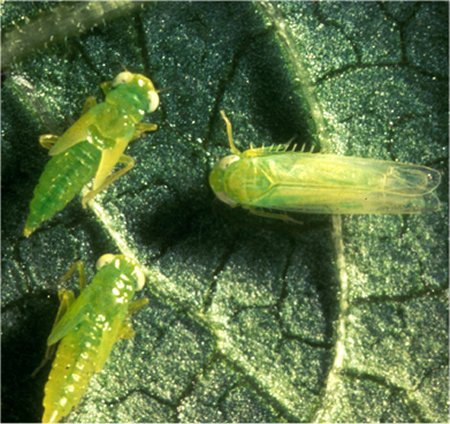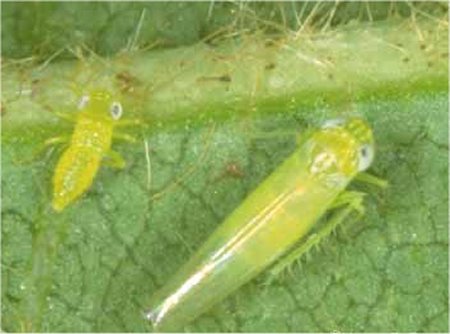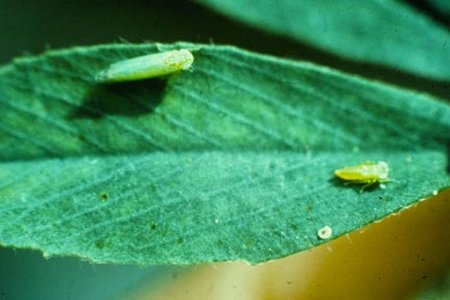
2005 Year in Review
Back to Agri-business: Agriculture Listing | Back to Year in Review Index
From the Fields - Potato Leafhoppers |
|
Source: Jim Morrison, Extension Educator, Crop Systems, Rockford Extension Center, University of Illinois, Phone 815/397-7714; FAX 815/397-8620; Email: morrison@uiuc.edu They’re back! Potato leafhoppers have arrived and found alfalfa fields. They are the most destructive pests of alfalfa. Leafhoppers can greatly reduce the quality, quantity, vigor, and delay the maturity of alfalfa. Severely damaged plants are more susceptible to winter injury. This pest can persist in fields, after the first harvest, until frosts occur in the fall. Hot, dry conditions are conducive to their development and they can complete several generations in a year. When the generations begin to overlap, their numbers can double in size in about 8 ½ days. The adult stage of this pest is lime green, wedge-shaped, soft bodied, approximately one-eighth of an inch long and is very active and either jumps or flies when disturbed. The nymph (immature stage) is yellow-green and lack wings. Both the adult and nymph feed by removing sap and fluid from alfalfa leaves with their piercing-sucking mouthparts. As they feed, compounds that are toxic to alfalfa are injected into the plant. These compounds block the conducting tissues resulting in an accumulation of starches that produces the characteristic V-shaped yellowing at the tips of the leaflets. This symptom is referred to as “hopperburn”. As damage progresses, leaves will yellow and eventually redden or brown, and the plant will be stunted and bushy since the internodes stop growing. Don’t confuse hopperburn with disease and nutritional disorders that have similar leaf symptoms. For example, boron deficiency, which is quite similar to leafhopper injury, is usually limited to younger leaves, whereas leafhopper injury is found on older leaves. A 15-inch diameter sweep net should be used to check for the presence of leafhoppers. Watch field edges for the first signs of leafhopper feeding as the insects move into the field. The need to treat is based not on the degree of visible damage, but rather on the height of the alfalfa and the numbers of leafhoppers caught per sweep of the net. University of Illinois guidelines are: alfalfa less than 3 inches tall, 0.2 leafhopper per sweep; 3 to 6 inches tall, 0.5 leafhopper; 6 to 12 inches tall, 1.0 leafhopper; and greater than 12 inches tall, 2.0 leafhoppers per sweep. Weekly scouting with a sweep net is needed to detect population levels of leafhoppers. Alfalfa foliage must be dry for sweeping. Various insecticides can be applied if the threshold is exceeded. Observe the interval between application and harvest plus other label directions. Don’t wait until the symptoms mentioned above appear before treating. By the time symptoms are evident, damage has been done and treatment will not correct the problem. Harvest will cause the adult leafhoppers that are present to fly to other fields and many of the nymphs will be killed. This is the reason that an insecticide should not be applied to the stubble at harvest time. Secondly, leafhoppers will not feed on the stubble. Tender, new alfalfa growth is very attractive to the insect and will cause the adult pest to move back into regrowing fields. Thus, keep a close eye on the regrowth after each harvest. Growers also need to watch the performance of potato leafhopper resistant varieties that have been released by many seed companies. Improvements in the level of “resistance” occur almost yearly. For more information on the potato leafhopper, contact an Extension office or see a University of Illinois fact sheet at this web site: Potato Leafhopper by Editor, theCity1.com |
|
Copyright © 2005 TheCity1.com.
All rights reserved


